An Analysis of AI Ethics, Sustainability, and Social Impact in the UK
VerifiedAdded on 2023/01/09
|9
|2683
|54
Report
AI Summary
This report delves into the ethical, sustainable, and social impacts of Artificial Intelligence (AI), focusing on its implementation in the UK. It begins with an overview of AI, defining its function and pervasive presence across various industries. The report then explores ethical frameworks, including Utilitarianism, Deontology, and Rawls' Theory of Justice, analyzing their principles and applications to AI. A key focus is the ethical considerations of facial recognition technology (FRT), evaluating its implications through the lens of each ethical theory. The analysis considers the benefits of FRT in security and crime prevention, the potential violations of individual privacy, and the complexities of balancing societal good with individual rights. The report concludes by summarizing the ethical dilemmas presented by AI and FRT, highlighting the need for a nuanced approach that considers both the advantages and the potential harms of these technologies.
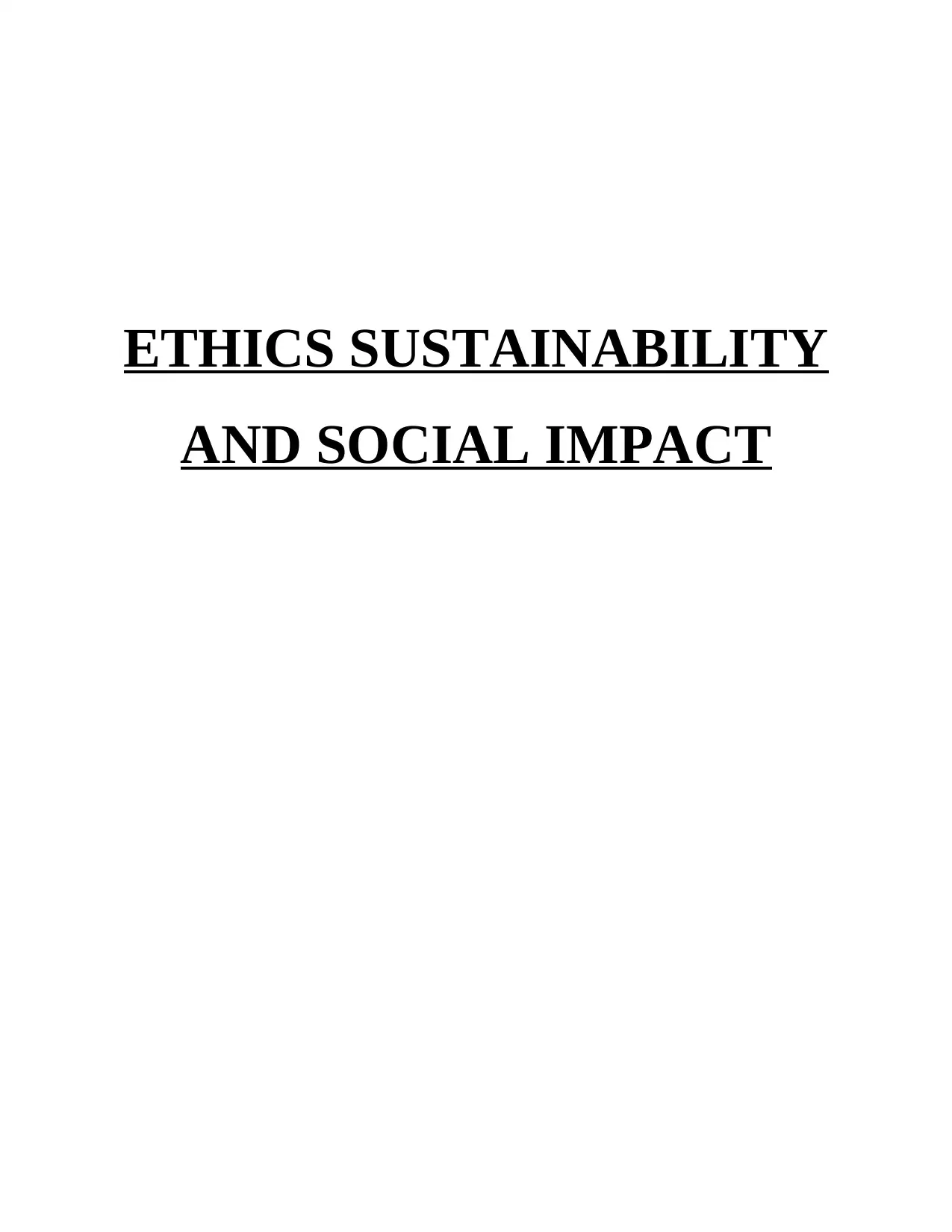
ETHICS SUSTAINABILITY
AND SOCIAL IMPACT
AND SOCIAL IMPACT
Paraphrase This Document
Need a fresh take? Get an instant paraphrase of this document with our AI Paraphraser
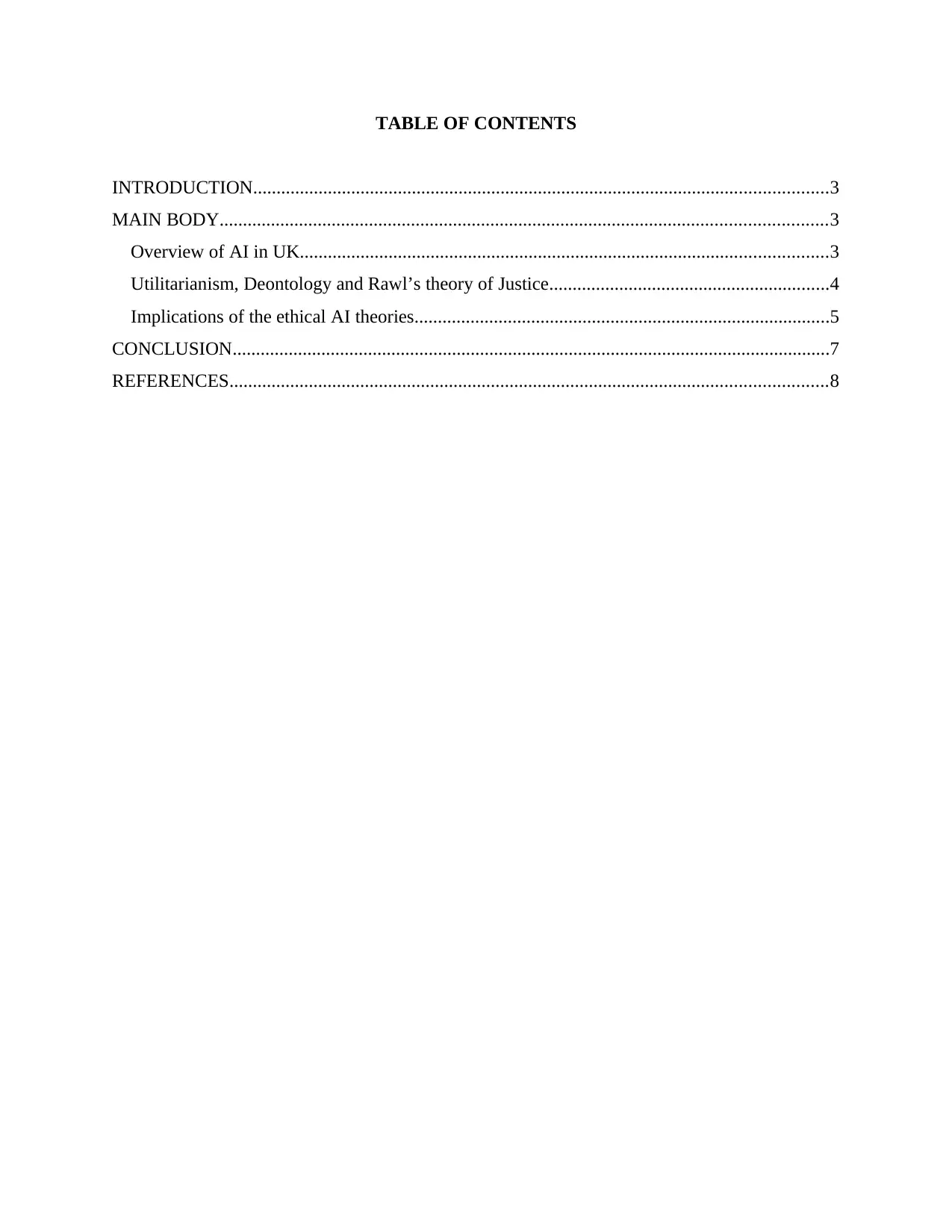
TABLE OF CONTENTS
INTRODUCTION...........................................................................................................................3
MAIN BODY..................................................................................................................................3
Overview of AI in UK.................................................................................................................3
Utilitarianism, Deontology and Rawl’s theory of Justice............................................................4
Implications of the ethical AI theories.........................................................................................5
CONCLUSION................................................................................................................................7
REFERENCES................................................................................................................................8
INTRODUCTION...........................................................................................................................3
MAIN BODY..................................................................................................................................3
Overview of AI in UK.................................................................................................................3
Utilitarianism, Deontology and Rawl’s theory of Justice............................................................4
Implications of the ethical AI theories.........................................................................................5
CONCLUSION................................................................................................................................7
REFERENCES................................................................................................................................8
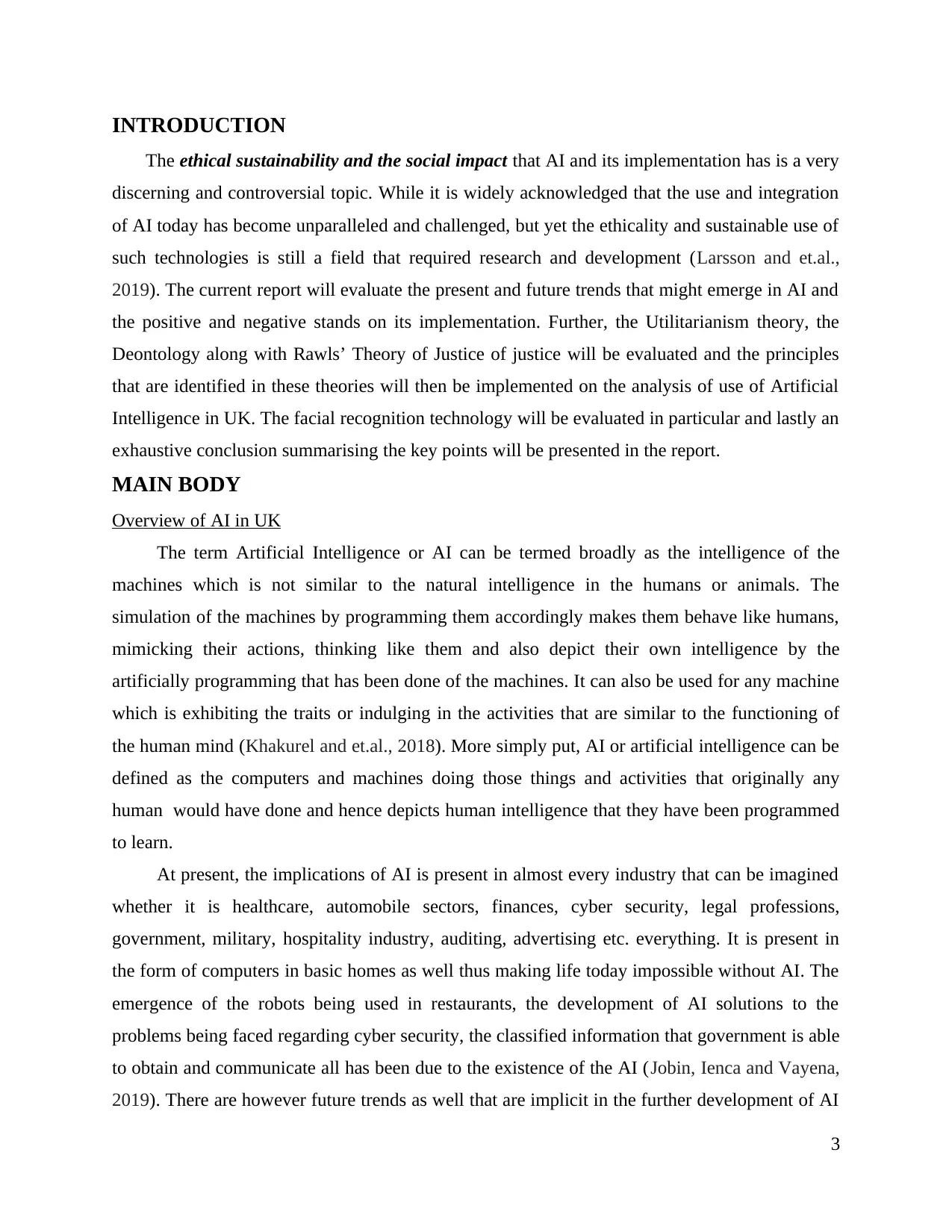
INTRODUCTION
The ethical sustainability and the social impact that AI and its implementation has is a very
discerning and controversial topic. While it is widely acknowledged that the use and integration
of AI today has become unparalleled and challenged, but yet the ethicality and sustainable use of
such technologies is still a field that required research and development (Larsson and et.al.,
2019). The current report will evaluate the present and future trends that might emerge in AI and
the positive and negative stands on its implementation. Further, the Utilitarianism theory, the
Deontology along with Rawls’ Theory of Justice of justice will be evaluated and the principles
that are identified in these theories will then be implemented on the analysis of use of Artificial
Intelligence in UK. The facial recognition technology will be evaluated in particular and lastly an
exhaustive conclusion summarising the key points will be presented in the report.
MAIN BODY
Overview of AI in UK
The term Artificial Intelligence or AI can be termed broadly as the intelligence of the
machines which is not similar to the natural intelligence in the humans or animals. The
simulation of the machines by programming them accordingly makes them behave like humans,
mimicking their actions, thinking like them and also depict their own intelligence by the
artificially programming that has been done of the machines. It can also be used for any machine
which is exhibiting the traits or indulging in the activities that are similar to the functioning of
the human mind (Khakurel and et.al., 2018). More simply put, AI or artificial intelligence can be
defined as the computers and machines doing those things and activities that originally any
human would have done and hence depicts human intelligence that they have been programmed
to learn.
At present, the implications of AI is present in almost every industry that can be imagined
whether it is healthcare, automobile sectors, finances, cyber security, legal professions,
government, military, hospitality industry, auditing, advertising etc. everything. It is present in
the form of computers in basic homes as well thus making life today impossible without AI. The
emergence of the robots being used in restaurants, the development of AI solutions to the
problems being faced regarding cyber security, the classified information that government is able
to obtain and communicate all has been due to the existence of the AI (Jobin, Ienca and Vayena,
2019). There are however future trends as well that are implicit in the further development of AI
3
The ethical sustainability and the social impact that AI and its implementation has is a very
discerning and controversial topic. While it is widely acknowledged that the use and integration
of AI today has become unparalleled and challenged, but yet the ethicality and sustainable use of
such technologies is still a field that required research and development (Larsson and et.al.,
2019). The current report will evaluate the present and future trends that might emerge in AI and
the positive and negative stands on its implementation. Further, the Utilitarianism theory, the
Deontology along with Rawls’ Theory of Justice of justice will be evaluated and the principles
that are identified in these theories will then be implemented on the analysis of use of Artificial
Intelligence in UK. The facial recognition technology will be evaluated in particular and lastly an
exhaustive conclusion summarising the key points will be presented in the report.
MAIN BODY
Overview of AI in UK
The term Artificial Intelligence or AI can be termed broadly as the intelligence of the
machines which is not similar to the natural intelligence in the humans or animals. The
simulation of the machines by programming them accordingly makes them behave like humans,
mimicking their actions, thinking like them and also depict their own intelligence by the
artificially programming that has been done of the machines. It can also be used for any machine
which is exhibiting the traits or indulging in the activities that are similar to the functioning of
the human mind (Khakurel and et.al., 2018). More simply put, AI or artificial intelligence can be
defined as the computers and machines doing those things and activities that originally any
human would have done and hence depicts human intelligence that they have been programmed
to learn.
At present, the implications of AI is present in almost every industry that can be imagined
whether it is healthcare, automobile sectors, finances, cyber security, legal professions,
government, military, hospitality industry, auditing, advertising etc. everything. It is present in
the form of computers in basic homes as well thus making life today impossible without AI. The
emergence of the robots being used in restaurants, the development of AI solutions to the
problems being faced regarding cyber security, the classified information that government is able
to obtain and communicate all has been due to the existence of the AI (Jobin, Ienca and Vayena,
2019). There are however future trends as well that are implicit in the further development of AI
3
⊘ This is a preview!⊘
Do you want full access?
Subscribe today to unlock all pages.

Trusted by 1+ million students worldwide
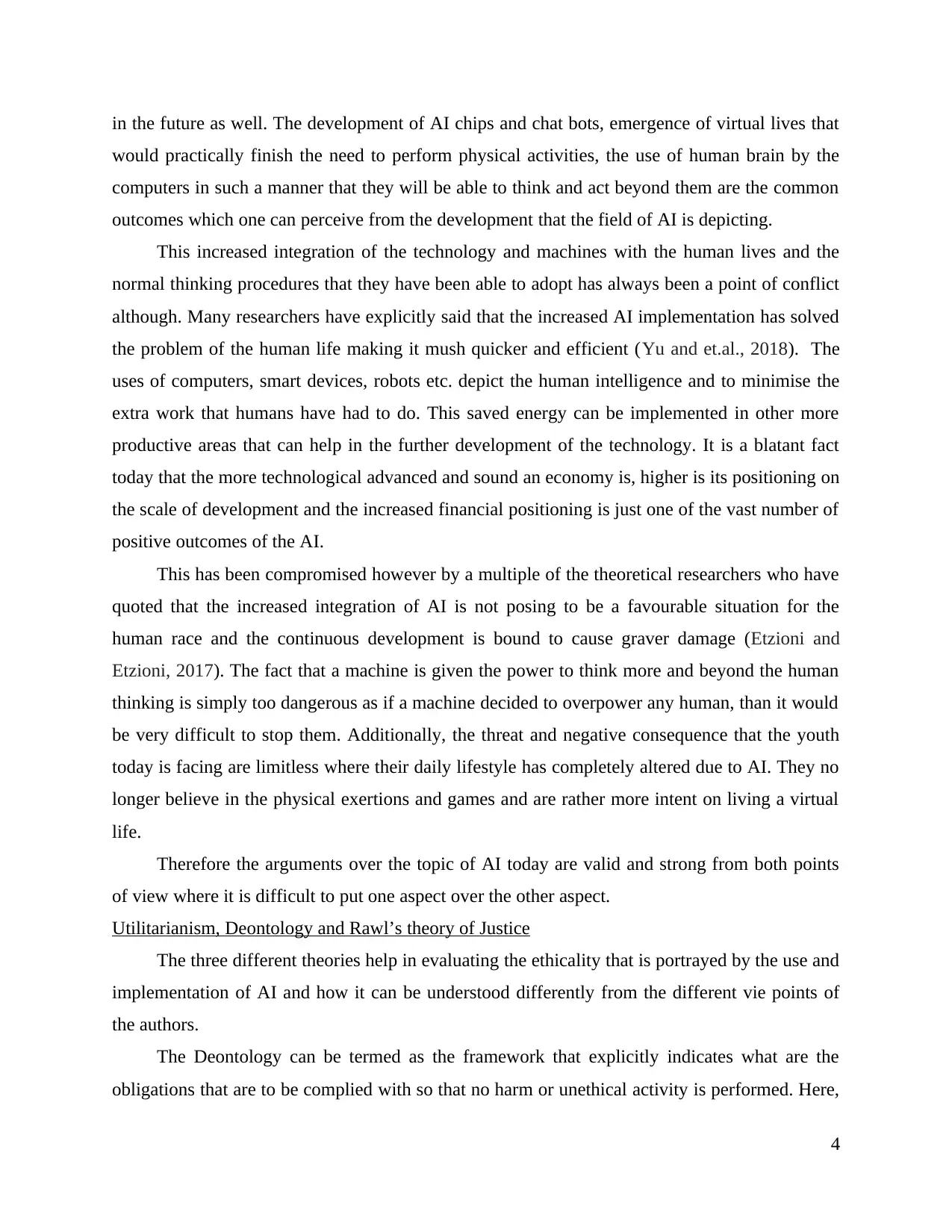
in the future as well. The development of AI chips and chat bots, emergence of virtual lives that
would practically finish the need to perform physical activities, the use of human brain by the
computers in such a manner that they will be able to think and act beyond them are the common
outcomes which one can perceive from the development that the field of AI is depicting.
This increased integration of the technology and machines with the human lives and the
normal thinking procedures that they have been able to adopt has always been a point of conflict
although. Many researchers have explicitly said that the increased AI implementation has solved
the problem of the human life making it mush quicker and efficient (Yu and et.al., 2018). The
uses of computers, smart devices, robots etc. depict the human intelligence and to minimise the
extra work that humans have had to do. This saved energy can be implemented in other more
productive areas that can help in the further development of the technology. It is a blatant fact
today that the more technological advanced and sound an economy is, higher is its positioning on
the scale of development and the increased financial positioning is just one of the vast number of
positive outcomes of the AI.
This has been compromised however by a multiple of the theoretical researchers who have
quoted that the increased integration of AI is not posing to be a favourable situation for the
human race and the continuous development is bound to cause graver damage (Etzioni and
Etzioni, 2017). The fact that a machine is given the power to think more and beyond the human
thinking is simply too dangerous as if a machine decided to overpower any human, than it would
be very difficult to stop them. Additionally, the threat and negative consequence that the youth
today is facing are limitless where their daily lifestyle has completely altered due to AI. They no
longer believe in the physical exertions and games and are rather more intent on living a virtual
life.
Therefore the arguments over the topic of AI today are valid and strong from both points
of view where it is difficult to put one aspect over the other aspect.
Utilitarianism, Deontology and Rawl’s theory of Justice
The three different theories help in evaluating the ethicality that is portrayed by the use and
implementation of AI and how it can be understood differently from the different vie points of
the authors.
The Deontology can be termed as the framework that explicitly indicates what are the
obligations that are to be complied with so that no harm or unethical activity is performed. Here,
4
would practically finish the need to perform physical activities, the use of human brain by the
computers in such a manner that they will be able to think and act beyond them are the common
outcomes which one can perceive from the development that the field of AI is depicting.
This increased integration of the technology and machines with the human lives and the
normal thinking procedures that they have been able to adopt has always been a point of conflict
although. Many researchers have explicitly said that the increased AI implementation has solved
the problem of the human life making it mush quicker and efficient (Yu and et.al., 2018). The
uses of computers, smart devices, robots etc. depict the human intelligence and to minimise the
extra work that humans have had to do. This saved energy can be implemented in other more
productive areas that can help in the further development of the technology. It is a blatant fact
today that the more technological advanced and sound an economy is, higher is its positioning on
the scale of development and the increased financial positioning is just one of the vast number of
positive outcomes of the AI.
This has been compromised however by a multiple of the theoretical researchers who have
quoted that the increased integration of AI is not posing to be a favourable situation for the
human race and the continuous development is bound to cause graver damage (Etzioni and
Etzioni, 2017). The fact that a machine is given the power to think more and beyond the human
thinking is simply too dangerous as if a machine decided to overpower any human, than it would
be very difficult to stop them. Additionally, the threat and negative consequence that the youth
today is facing are limitless where their daily lifestyle has completely altered due to AI. They no
longer believe in the physical exertions and games and are rather more intent on living a virtual
life.
Therefore the arguments over the topic of AI today are valid and strong from both points
of view where it is difficult to put one aspect over the other aspect.
Utilitarianism, Deontology and Rawl’s theory of Justice
The three different theories help in evaluating the ethicality that is portrayed by the use and
implementation of AI and how it can be understood differently from the different vie points of
the authors.
The Deontology can be termed as the framework that explicitly indicates what are the
obligations that are to be complied with so that no harm or unethical activity is performed. Here,
4
Paraphrase This Document
Need a fresh take? Get an instant paraphrase of this document with our AI Paraphraser
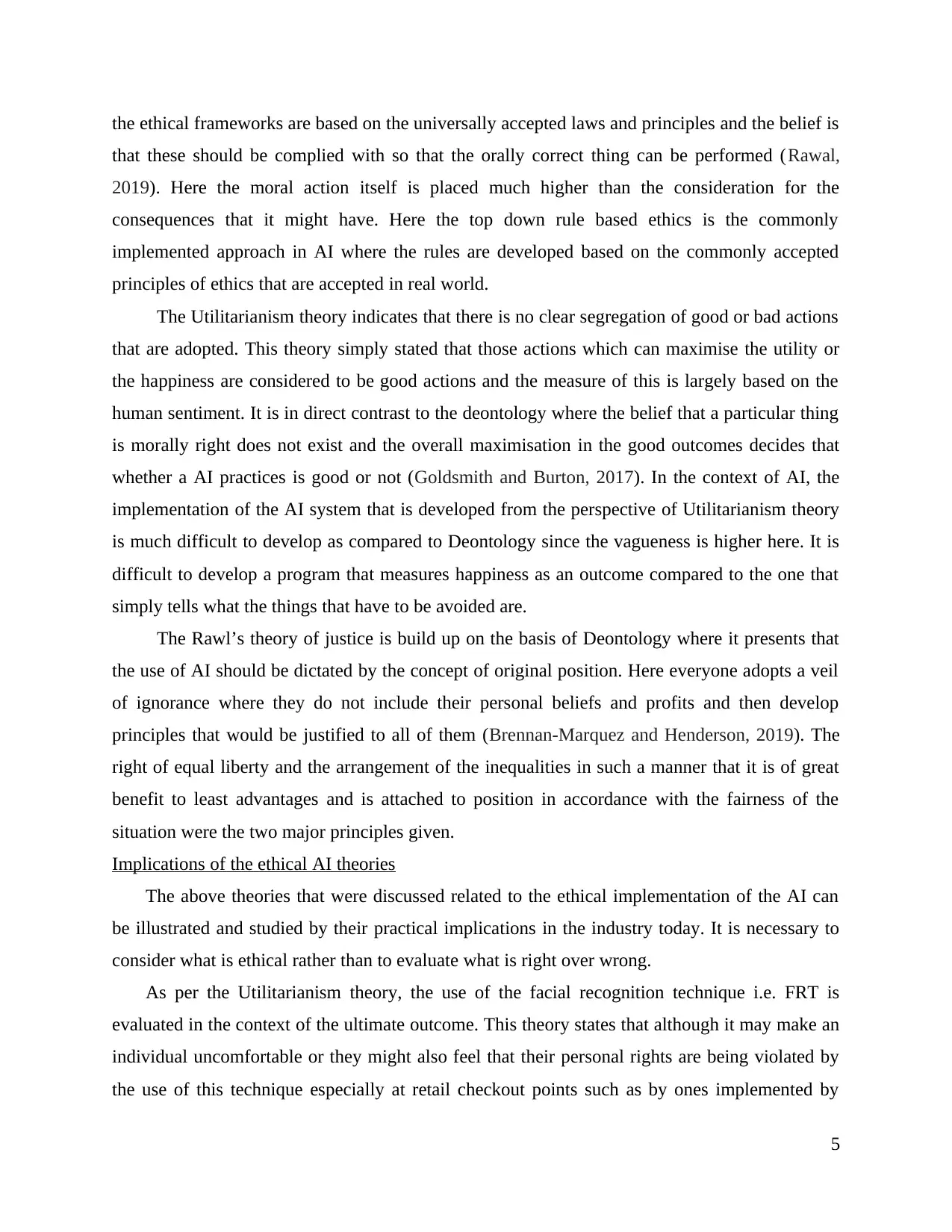
the ethical frameworks are based on the universally accepted laws and principles and the belief is
that these should be complied with so that the orally correct thing can be performed (Rawal,
2019). Here the moral action itself is placed much higher than the consideration for the
consequences that it might have. Here the top down rule based ethics is the commonly
implemented approach in AI where the rules are developed based on the commonly accepted
principles of ethics that are accepted in real world.
The Utilitarianism theory indicates that there is no clear segregation of good or bad actions
that are adopted. This theory simply stated that those actions which can maximise the utility or
the happiness are considered to be good actions and the measure of this is largely based on the
human sentiment. It is in direct contrast to the deontology where the belief that a particular thing
is morally right does not exist and the overall maximisation in the good outcomes decides that
whether a AI practices is good or not (Goldsmith and Burton, 2017). In the context of AI, the
implementation of the AI system that is developed from the perspective of Utilitarianism theory
is much difficult to develop as compared to Deontology since the vagueness is higher here. It is
difficult to develop a program that measures happiness as an outcome compared to the one that
simply tells what the things that have to be avoided are.
The Rawl’s theory of justice is build up on the basis of Deontology where it presents that
the use of AI should be dictated by the concept of original position. Here everyone adopts a veil
of ignorance where they do not include their personal beliefs and profits and then develop
principles that would be justified to all of them (Brennan-Marquez and Henderson, 2019). The
right of equal liberty and the arrangement of the inequalities in such a manner that it is of great
benefit to least advantages and is attached to position in accordance with the fairness of the
situation were the two major principles given.
Implications of the ethical AI theories
The above theories that were discussed related to the ethical implementation of the AI can
be illustrated and studied by their practical implications in the industry today. It is necessary to
consider what is ethical rather than to evaluate what is right over wrong.
As per the Utilitarianism theory, the use of the facial recognition technique i.e. FRT is
evaluated in the context of the ultimate outcome. This theory states that although it may make an
individual uncomfortable or they might also feel that their personal rights are being violated by
the use of this technique especially at retail checkout points such as by ones implemented by
5
that these should be complied with so that the orally correct thing can be performed (Rawal,
2019). Here the moral action itself is placed much higher than the consideration for the
consequences that it might have. Here the top down rule based ethics is the commonly
implemented approach in AI where the rules are developed based on the commonly accepted
principles of ethics that are accepted in real world.
The Utilitarianism theory indicates that there is no clear segregation of good or bad actions
that are adopted. This theory simply stated that those actions which can maximise the utility or
the happiness are considered to be good actions and the measure of this is largely based on the
human sentiment. It is in direct contrast to the deontology where the belief that a particular thing
is morally right does not exist and the overall maximisation in the good outcomes decides that
whether a AI practices is good or not (Goldsmith and Burton, 2017). In the context of AI, the
implementation of the AI system that is developed from the perspective of Utilitarianism theory
is much difficult to develop as compared to Deontology since the vagueness is higher here. It is
difficult to develop a program that measures happiness as an outcome compared to the one that
simply tells what the things that have to be avoided are.
The Rawl’s theory of justice is build up on the basis of Deontology where it presents that
the use of AI should be dictated by the concept of original position. Here everyone adopts a veil
of ignorance where they do not include their personal beliefs and profits and then develop
principles that would be justified to all of them (Brennan-Marquez and Henderson, 2019). The
right of equal liberty and the arrangement of the inequalities in such a manner that it is of great
benefit to least advantages and is attached to position in accordance with the fairness of the
situation were the two major principles given.
Implications of the ethical AI theories
The above theories that were discussed related to the ethical implementation of the AI can
be illustrated and studied by their practical implications in the industry today. It is necessary to
consider what is ethical rather than to evaluate what is right over wrong.
As per the Utilitarianism theory, the use of the facial recognition technique i.e. FRT is
evaluated in the context of the ultimate outcome. This theory states that although it may make an
individual uncomfortable or they might also feel that their personal rights are being violated by
the use of this technique especially at retail checkout points such as by ones implemented by
5
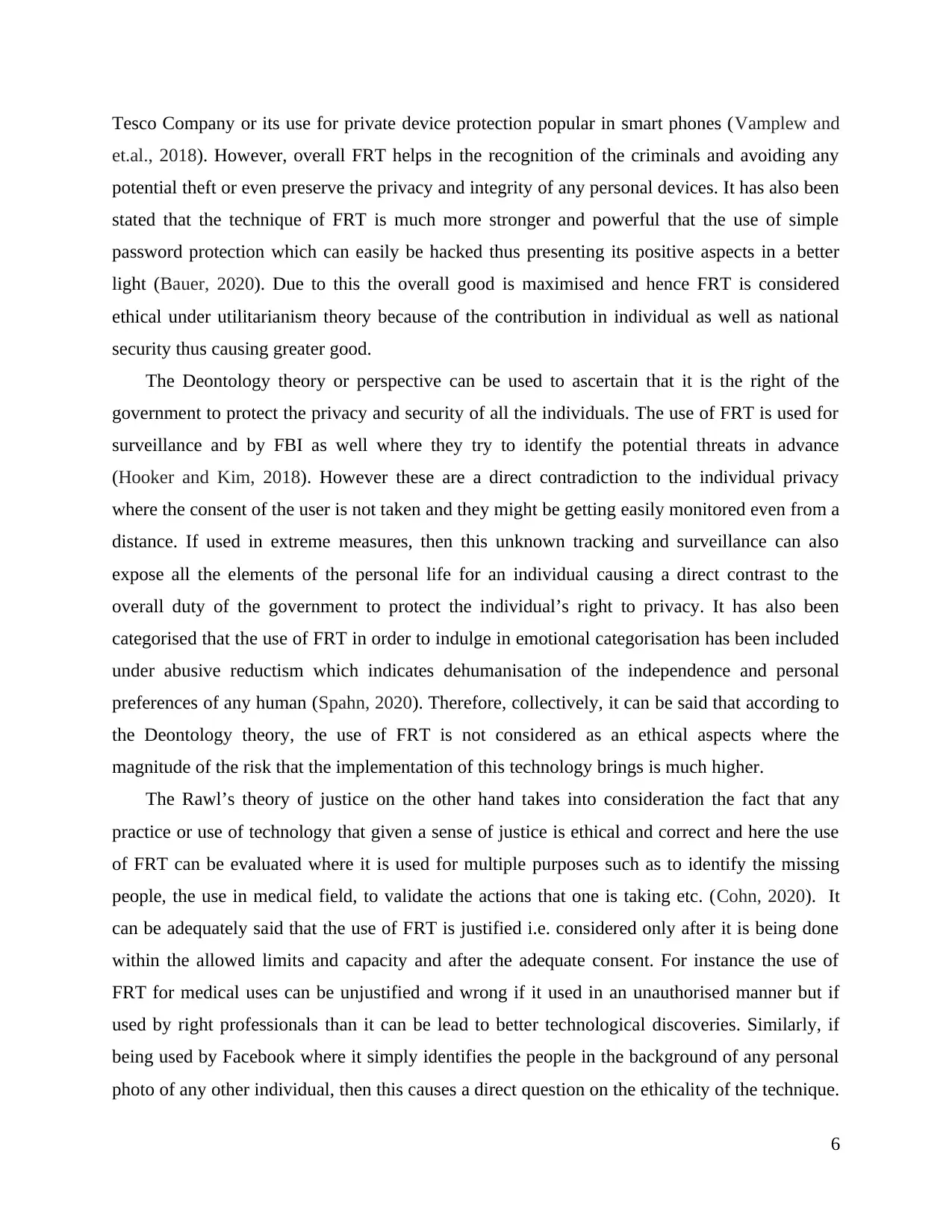
Tesco Company or its use for private device protection popular in smart phones (Vamplew and
et.al., 2018). However, overall FRT helps in the recognition of the criminals and avoiding any
potential theft or even preserve the privacy and integrity of any personal devices. It has also been
stated that the technique of FRT is much more stronger and powerful that the use of simple
password protection which can easily be hacked thus presenting its positive aspects in a better
light (Bauer, 2020). Due to this the overall good is maximised and hence FRT is considered
ethical under utilitarianism theory because of the contribution in individual as well as national
security thus causing greater good.
The Deontology theory or perspective can be used to ascertain that it is the right of the
government to protect the privacy and security of all the individuals. The use of FRT is used for
surveillance and by FBI as well where they try to identify the potential threats in advance
(Hooker and Kim, 2018). However these are a direct contradiction to the individual privacy
where the consent of the user is not taken and they might be getting easily monitored even from a
distance. If used in extreme measures, then this unknown tracking and surveillance can also
expose all the elements of the personal life for an individual causing a direct contrast to the
overall duty of the government to protect the individual’s right to privacy. It has also been
categorised that the use of FRT in order to indulge in emotional categorisation has been included
under abusive reductism which indicates dehumanisation of the independence and personal
preferences of any human (Spahn, 2020). Therefore, collectively, it can be said that according to
the Deontology theory, the use of FRT is not considered as an ethical aspects where the
magnitude of the risk that the implementation of this technology brings is much higher.
The Rawl’s theory of justice on the other hand takes into consideration the fact that any
practice or use of technology that given a sense of justice is ethical and correct and here the use
of FRT can be evaluated where it is used for multiple purposes such as to identify the missing
people, the use in medical field, to validate the actions that one is taking etc. (Cohn, 2020). It
can be adequately said that the use of FRT is justified i.e. considered only after it is being done
within the allowed limits and capacity and after the adequate consent. For instance the use of
FRT for medical uses can be unjustified and wrong if it used in an unauthorised manner but if
used by right professionals than it can be lead to better technological discoveries. Similarly, if
being used by Facebook where it simply identifies the people in the background of any personal
photo of any other individual, then this causes a direct question on the ethicality of the technique.
6
et.al., 2018). However, overall FRT helps in the recognition of the criminals and avoiding any
potential theft or even preserve the privacy and integrity of any personal devices. It has also been
stated that the technique of FRT is much more stronger and powerful that the use of simple
password protection which can easily be hacked thus presenting its positive aspects in a better
light (Bauer, 2020). Due to this the overall good is maximised and hence FRT is considered
ethical under utilitarianism theory because of the contribution in individual as well as national
security thus causing greater good.
The Deontology theory or perspective can be used to ascertain that it is the right of the
government to protect the privacy and security of all the individuals. The use of FRT is used for
surveillance and by FBI as well where they try to identify the potential threats in advance
(Hooker and Kim, 2018). However these are a direct contradiction to the individual privacy
where the consent of the user is not taken and they might be getting easily monitored even from a
distance. If used in extreme measures, then this unknown tracking and surveillance can also
expose all the elements of the personal life for an individual causing a direct contrast to the
overall duty of the government to protect the individual’s right to privacy. It has also been
categorised that the use of FRT in order to indulge in emotional categorisation has been included
under abusive reductism which indicates dehumanisation of the independence and personal
preferences of any human (Spahn, 2020). Therefore, collectively, it can be said that according to
the Deontology theory, the use of FRT is not considered as an ethical aspects where the
magnitude of the risk that the implementation of this technology brings is much higher.
The Rawl’s theory of justice on the other hand takes into consideration the fact that any
practice or use of technology that given a sense of justice is ethical and correct and here the use
of FRT can be evaluated where it is used for multiple purposes such as to identify the missing
people, the use in medical field, to validate the actions that one is taking etc. (Cohn, 2020). It
can be adequately said that the use of FRT is justified i.e. considered only after it is being done
within the allowed limits and capacity and after the adequate consent. For instance the use of
FRT for medical uses can be unjustified and wrong if it used in an unauthorised manner but if
used by right professionals than it can be lead to better technological discoveries. Similarly, if
being used by Facebook where it simply identifies the people in the background of any personal
photo of any other individual, then this causes a direct question on the ethicality of the technique.
6
⊘ This is a preview!⊘
Do you want full access?
Subscribe today to unlock all pages.

Trusted by 1+ million students worldwide
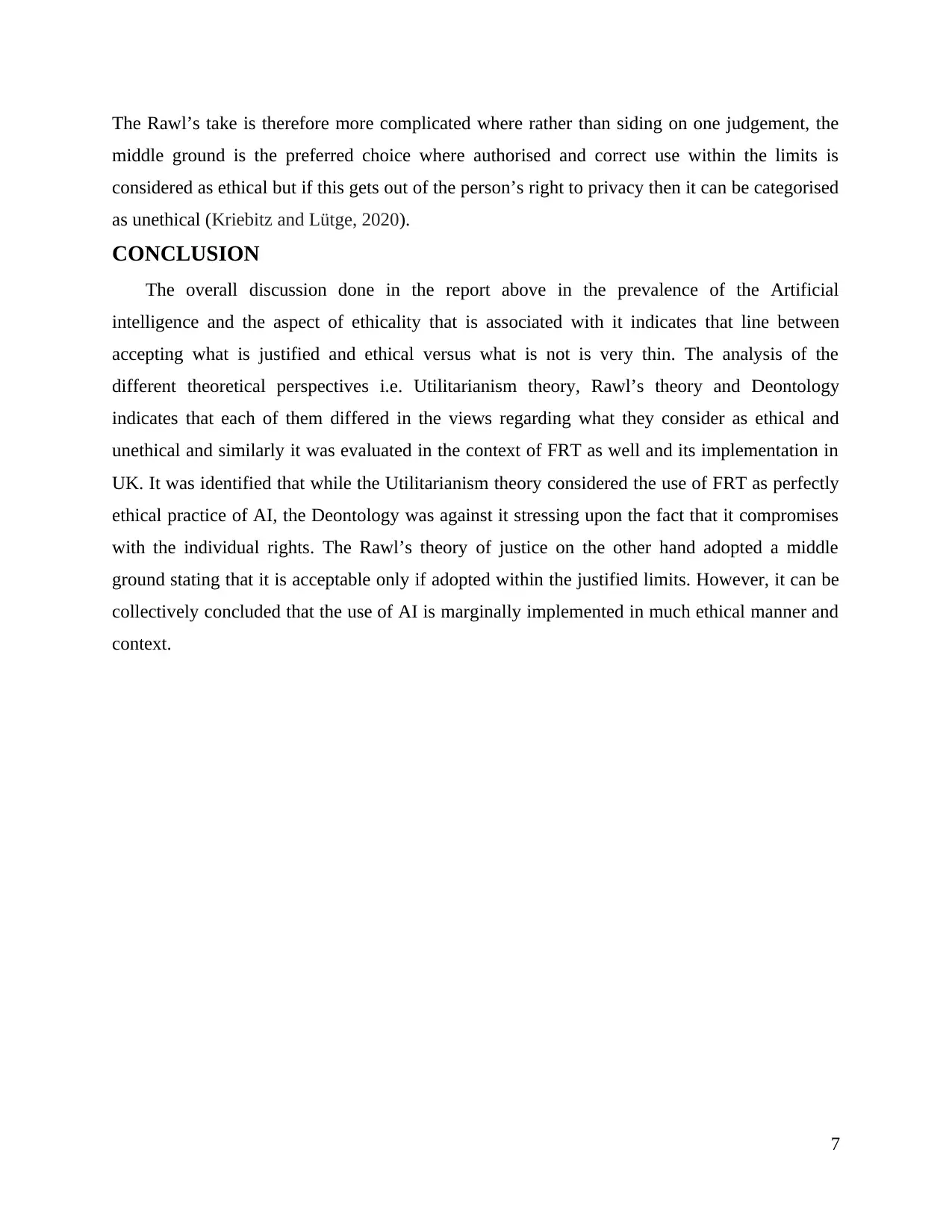
The Rawl’s take is therefore more complicated where rather than siding on one judgement, the
middle ground is the preferred choice where authorised and correct use within the limits is
considered as ethical but if this gets out of the person’s right to privacy then it can be categorised
as unethical (Kriebitz and Lütge, 2020).
CONCLUSION
The overall discussion done in the report above in the prevalence of the Artificial
intelligence and the aspect of ethicality that is associated with it indicates that line between
accepting what is justified and ethical versus what is not is very thin. The analysis of the
different theoretical perspectives i.e. Utilitarianism theory, Rawl’s theory and Deontology
indicates that each of them differed in the views regarding what they consider as ethical and
unethical and similarly it was evaluated in the context of FRT as well and its implementation in
UK. It was identified that while the Utilitarianism theory considered the use of FRT as perfectly
ethical practice of AI, the Deontology was against it stressing upon the fact that it compromises
with the individual rights. The Rawl’s theory of justice on the other hand adopted a middle
ground stating that it is acceptable only if adopted within the justified limits. However, it can be
collectively concluded that the use of AI is marginally implemented in much ethical manner and
context.
7
middle ground is the preferred choice where authorised and correct use within the limits is
considered as ethical but if this gets out of the person’s right to privacy then it can be categorised
as unethical (Kriebitz and Lütge, 2020).
CONCLUSION
The overall discussion done in the report above in the prevalence of the Artificial
intelligence and the aspect of ethicality that is associated with it indicates that line between
accepting what is justified and ethical versus what is not is very thin. The analysis of the
different theoretical perspectives i.e. Utilitarianism theory, Rawl’s theory and Deontology
indicates that each of them differed in the views regarding what they consider as ethical and
unethical and similarly it was evaluated in the context of FRT as well and its implementation in
UK. It was identified that while the Utilitarianism theory considered the use of FRT as perfectly
ethical practice of AI, the Deontology was against it stressing upon the fact that it compromises
with the individual rights. The Rawl’s theory of justice on the other hand adopted a middle
ground stating that it is acceptable only if adopted within the justified limits. However, it can be
collectively concluded that the use of AI is marginally implemented in much ethical manner and
context.
7
Paraphrase This Document
Need a fresh take? Get an instant paraphrase of this document with our AI Paraphraser
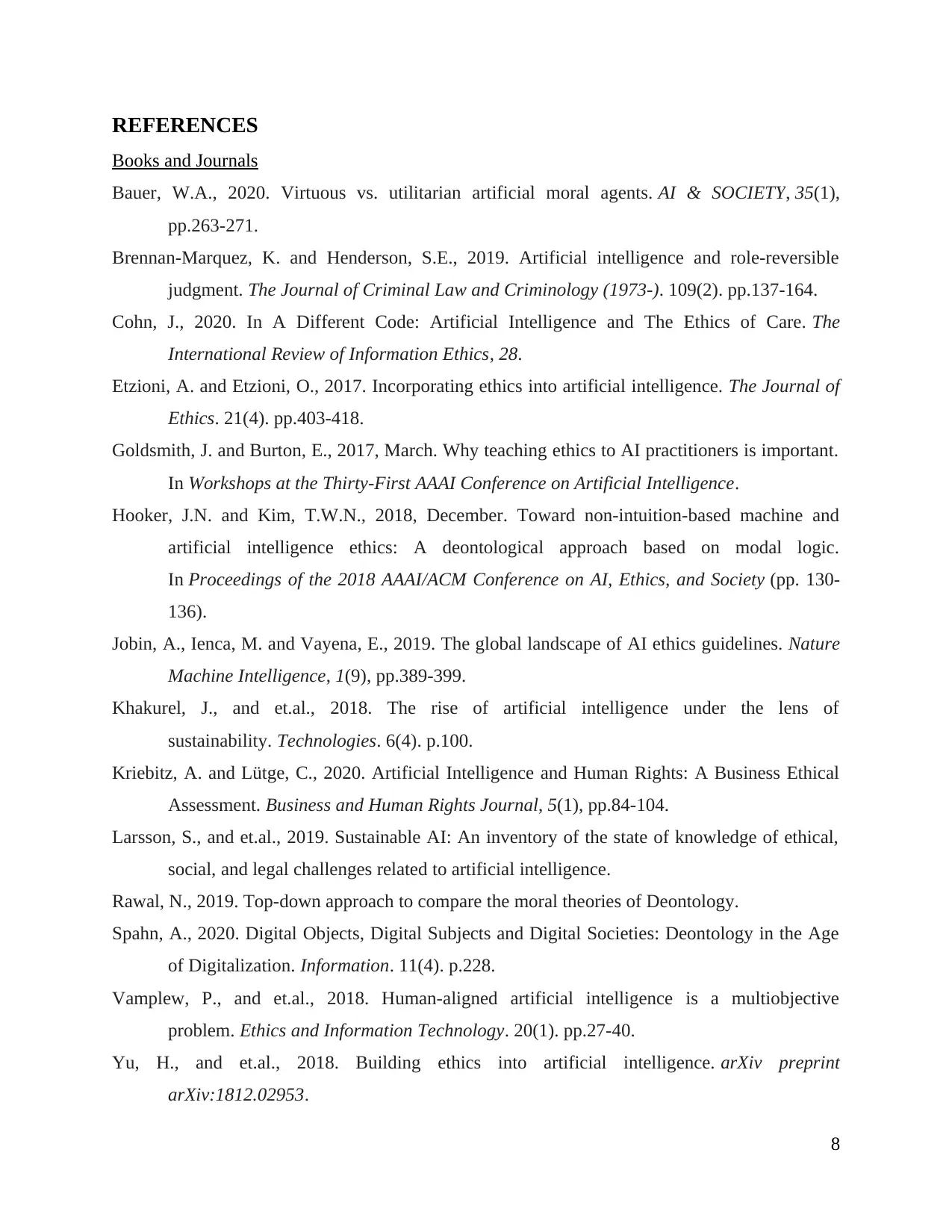
REFERENCES
Books and Journals
Bauer, W.A., 2020. Virtuous vs. utilitarian artificial moral agents. AI & SOCIETY, 35(1),
pp.263-271.
Brennan-Marquez, K. and Henderson, S.E., 2019. Artificial intelligence and role-reversible
judgment. The Journal of Criminal Law and Criminology (1973-). 109(2). pp.137-164.
Cohn, J., 2020. In A Different Code: Artificial Intelligence and The Ethics of Care. The
International Review of Information Ethics, 28.
Etzioni, A. and Etzioni, O., 2017. Incorporating ethics into artificial intelligence. The Journal of
Ethics. 21(4). pp.403-418.
Goldsmith, J. and Burton, E., 2017, March. Why teaching ethics to AI practitioners is important.
In Workshops at the Thirty-First AAAI Conference on Artificial Intelligence.
Hooker, J.N. and Kim, T.W.N., 2018, December. Toward non-intuition-based machine and
artificial intelligence ethics: A deontological approach based on modal logic.
In Proceedings of the 2018 AAAI/ACM Conference on AI, Ethics, and Society (pp. 130-
136).
Jobin, A., Ienca, M. and Vayena, E., 2019. The global landscape of AI ethics guidelines. Nature
Machine Intelligence, 1(9), pp.389-399.
Khakurel, J., and et.al., 2018. The rise of artificial intelligence under the lens of
sustainability. Technologies. 6(4). p.100.
Kriebitz, A. and Lütge, C., 2020. Artificial Intelligence and Human Rights: A Business Ethical
Assessment. Business and Human Rights Journal, 5(1), pp.84-104.
Larsson, S., and et.al., 2019. Sustainable AI: An inventory of the state of knowledge of ethical,
social, and legal challenges related to artificial intelligence.
Rawal, N., 2019. Top-down approach to compare the moral theories of Deontology.
Spahn, A., 2020. Digital Objects, Digital Subjects and Digital Societies: Deontology in the Age
of Digitalization. Information. 11(4). p.228.
Vamplew, P., and et.al., 2018. Human-aligned artificial intelligence is a multiobjective
problem. Ethics and Information Technology. 20(1). pp.27-40.
Yu, H., and et.al., 2018. Building ethics into artificial intelligence. arXiv preprint
arXiv:1812.02953.
8
Books and Journals
Bauer, W.A., 2020. Virtuous vs. utilitarian artificial moral agents. AI & SOCIETY, 35(1),
pp.263-271.
Brennan-Marquez, K. and Henderson, S.E., 2019. Artificial intelligence and role-reversible
judgment. The Journal of Criminal Law and Criminology (1973-). 109(2). pp.137-164.
Cohn, J., 2020. In A Different Code: Artificial Intelligence and The Ethics of Care. The
International Review of Information Ethics, 28.
Etzioni, A. and Etzioni, O., 2017. Incorporating ethics into artificial intelligence. The Journal of
Ethics. 21(4). pp.403-418.
Goldsmith, J. and Burton, E., 2017, March. Why teaching ethics to AI practitioners is important.
In Workshops at the Thirty-First AAAI Conference on Artificial Intelligence.
Hooker, J.N. and Kim, T.W.N., 2018, December. Toward non-intuition-based machine and
artificial intelligence ethics: A deontological approach based on modal logic.
In Proceedings of the 2018 AAAI/ACM Conference on AI, Ethics, and Society (pp. 130-
136).
Jobin, A., Ienca, M. and Vayena, E., 2019. The global landscape of AI ethics guidelines. Nature
Machine Intelligence, 1(9), pp.389-399.
Khakurel, J., and et.al., 2018. The rise of artificial intelligence under the lens of
sustainability. Technologies. 6(4). p.100.
Kriebitz, A. and Lütge, C., 2020. Artificial Intelligence and Human Rights: A Business Ethical
Assessment. Business and Human Rights Journal, 5(1), pp.84-104.
Larsson, S., and et.al., 2019. Sustainable AI: An inventory of the state of knowledge of ethical,
social, and legal challenges related to artificial intelligence.
Rawal, N., 2019. Top-down approach to compare the moral theories of Deontology.
Spahn, A., 2020. Digital Objects, Digital Subjects and Digital Societies: Deontology in the Age
of Digitalization. Information. 11(4). p.228.
Vamplew, P., and et.al., 2018. Human-aligned artificial intelligence is a multiobjective
problem. Ethics and Information Technology. 20(1). pp.27-40.
Yu, H., and et.al., 2018. Building ethics into artificial intelligence. arXiv preprint
arXiv:1812.02953.
8

9
⊘ This is a preview!⊘
Do you want full access?
Subscribe today to unlock all pages.

Trusted by 1+ million students worldwide
1 out of 9
Related Documents
Your All-in-One AI-Powered Toolkit for Academic Success.
+13062052269
info@desklib.com
Available 24*7 on WhatsApp / Email
![[object Object]](/_next/static/media/star-bottom.7253800d.svg)
Unlock your academic potential
Copyright © 2020–2025 A2Z Services. All Rights Reserved. Developed and managed by ZUCOL.





